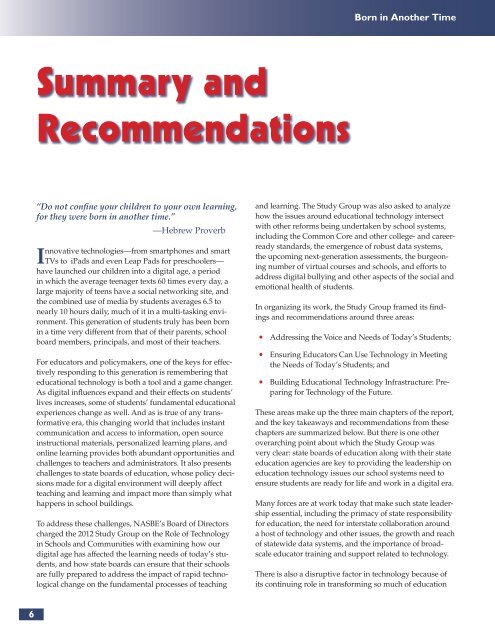You also want an ePaper? Increase the reach of your titles
YUMPU automatically turns print PDFs into web optimized ePapers that Google loves.
6<br />
Summary and<br />
Recommendations<br />
“Do not confi ne your children to your own learning,<br />
for they were born in another time.”<br />
—Hebrew Proverb<br />
Innovative technologies—from smartphones and smart<br />
TVs to iPads and even Leap Pads for preschoolers—<br />
have launched our children into a digital age, a period<br />
in which the average teenager texts 60 times every day, a<br />
large majority of teens have a social networking site, and<br />
the combined use of media by students averages 6.5 to<br />
nearly 10 hours daily, much of it in a multi-tasking environment.<br />
This generation of students truly has been born<br />
in a time very different from that of their parents, school<br />
board members, principals, and most of their teachers.<br />
For educators and policymakers, one of the keys for effectively<br />
responding to this generation is remembering that<br />
educational technology is both a tool and a game changer.<br />
As digital infl uences expand and their effects on students’<br />
lives increases, some of students’ fundamental educational<br />
experiences change as well. And as is true of any transformative<br />
era, this changing world that includes instant<br />
communication and access to information, open source<br />
instructional materials, personalized learning plans, and<br />
online learning provides both abundant opportunities and<br />
challenges to teachers and administrators. It also presents<br />
challenges to state boards of education, whose policy decisions<br />
made for a digital environment will deeply affect<br />
teaching and learning and impact more than simply what<br />
happens in school buildings.<br />
To address these challenges, <strong>NASBE</strong>’s Board of Directors<br />
charged the 2012 Study Group on the Role of Technology<br />
in Schools and Communities with examining how our<br />
digital age has affected the learning needs of today’s students,<br />
and how state boards can ensure that their schools<br />
are fully prepared to address the impact of rapid technological<br />
change on the fundamental processes of teaching<br />
Born in Another Time<br />
and learning. The Study Group was also asked to analyze<br />
how the issues around educational technology intersect<br />
with other reforms being undertaken by school systems,<br />
including the Common Core and other college- and careerready<br />
standards, the emergence of robust data systems,<br />
the upcoming next-generation assessments, the burgeoning<br />
number of virtual courses and schools, and efforts to<br />
address digital bullying and other aspects of the social and<br />
emotional health of students.<br />
In organizing its work, the Study Group framed its fi ndings<br />
and recommendations around three areas:<br />
Addressing the Voice and Needs of Today’s Students;<br />
Ensuring Educators Can Use Technology in Meeting<br />
the Needs of Today’s Students; and<br />
Building Educational Technology Infrastructure: Preparing<br />
for Technology of the Future.<br />
These areas make up the three main chapters of the report,<br />
and the key takeaways and recommendations from these<br />
chapters are summarized below. But there is one other<br />
overarching point about which the Study Group was<br />
very clear: state boards of education along with their state<br />
education agencies are key to providing the leadership on<br />
education technology issues our school systems need to<br />
ensure students are ready for life and work in a digital era.<br />
Many forces are at work today that make such state leadership<br />
essential, including the primacy of state responsibility<br />
for education, the need for interstate collaboration around<br />
a host of technology and other issues, the growth and reach<br />
of statewide data systems, and the importance of broadscale<br />
educator training and support related to technology.<br />
There is also a disruptive factor in technology because of<br />
its continuing role in transforming so much of education


